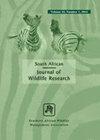Variable Barrier Permeability for a Pack of African Wild Dogs (Lycaon pictus) Reintroduced to Eastern Botswana
引用次数: 0
Abstract
INTRODUCTION Understanding how natural and artificial landscape barriers influence the movement of carnivores is important for conservation planning. Studies have shown that while both fences and rivers significantly influence carnivore movement, rivers are typically more impermeable to carnivores than fences (Blanco, Cortés & Virgós, 2005; Cozzi, Broekhuis, McNutt & Schmid, 2013; Pomilia, McNutt & Jordan, 2015). Nevertheless, the use of fencing to separate human development and wildlife remains a key feature of southern Africa’s land-sparing approach to biodiversity conservation (Bauer et al., 2015; Chapron et al., 2014; Gusset et al., 2008; Hayward & Kerley, 2009; Packer et al., 2013; Woodroffe, Hedges & Durrant, 2014). Securely fenced protected areas have played a fundamental role in ensuring the success of South Africa’s African wild dog (Lycaon pictus) metapopulation management approach through limiting conflict between humans and reintroduced African wild dogs (Davies-Mostert, Mills & Macdonald, 2009; Gusset et al., 2008). Poorly maintained fences have allowed pack breakouts from reintroduction sites and contact with humans, frequently leading to anthropogenic mortality in the form of direct persecution. Without effective human–wild dog conflict mitigation, fences will continue to play a pivotal role in future African wild dog reintroductions (Davies-Mostert et al., 2009; Gusset et al., 2008; Jackson, McNutt & Apps, 2012). It is important to analyse individual reintroduction attempts to inform future African wild dog reintroductions and meet the International Union for the Conservation of Nature’s need to understand how barriers impact this species’ movement (Davies-Mostert, Mills & Macdonald, 2015; IUCN, 2012).Here we investigated how rivers and fences impacted the movements of a pack of African wild dogs introduced to a reserve in eastern Botswana.重新引入博茨瓦纳东部的非洲野狗(Lycaon pictus)的可变屏障通透性
引言了解自然和人工景观屏障如何影响食肉动物的活动对保护规划很重要。研究表明,虽然围栏和河流都会显著影响食肉动物的运动,但河流通常比围栏更不渗透食肉动物(Blanco,Cortés&Virgós,2005;Cozzi,Broekhuis,McNutt&Schmid,2013;波米利亚,McNutt和约旦,2015年)。尽管如此,使用围栏来分隔人类发展和野生动物仍然是南部非洲保护生物多样性的土地节约方法的一个关键特征(Bauer等人,2015;Chapron等人,2014;Gusset等人,2008;Hayward和Kerley,2009;Packer等人,2013;Woodroffe、Hedges和Durrant,2014)。通过限制人类与重新引入的非洲野狗之间的冲突,安全围栏保护区在确保南非非洲野狗(Lycaon pictus)集合种群管理方法的成功方面发挥了根本作用(Davies-Mostert,Mills&Macdonald,2009;Gusset等人,2008年)。围栏维护不善,导致种群从重新引入地点爆发,并与人类接触,经常以直接迫害的形式导致人为死亡。如果没有有效的人与野狗冲突缓解措施,围栏将继续在未来非洲野狗的重新引入中发挥关键作用(Davies-Mostert等人,2009年;Gusset等人,2008年;Jackson、McNutt和Apps,2012年)。重要的是要分析个体重新引入的尝试,为未来非洲野狗的重新引入提供信息,并满足国际自然保护联盟了解障碍物如何影响该物种运动的需要(Davies-Mostert,Mills&Macdonald,2015;国际自然保护联盟,2012)。在这里,我们调查了河流和围栏如何影响一群非洲野狗运动引入博茨瓦纳东部的一个保护区。
本文章由计算机程序翻译,如有差异,请以英文原文为准。
求助全文
约1分钟内获得全文
求助全文

 求助内容:
求助内容: 应助结果提醒方式:
应助结果提醒方式:


